 Last Updated February 9, 2025
Last Updated February 9, 2025
The most common Vitamix shopper’s question is some variant of, “I want to make smoothies, soups, and frozen desserts. Which Vitamix blender is best for me?” The answer is that all Vitamix machines work great for those tasks; which one is best depends on the volumes you want to blend and whether you want to pay for extra features.
If you don’t want to go through the nitty-gritty, here are my quick Vitamix recommendations:
Which is the best Vitamix model?
Best Value
- E310 (short/narrow container for small to medium amounts)
- Recon 5200 (tall/narrow container for small to large amounts)
- Recon E320 (short/wide container for medium to large amounts)
Money Is No Object
- Ascent X5 (latest and greatest)
The February 2025 shopping landscape
Most Vitamix models are on sale through Feb 22nd for the President’s Day Sale. Here is the sale.
Vitamix recently released a new set of Ascent models. Full details are in my Vitamix Ascent X Series Review.
The Food Processor Attachment gives more reason to consider Ascent and Venturist models, since it is not compatible with classic models. If you don’t care about the premium finish of the A3500, consider saving big on the Reconditioned Venturist.
If you are looking for the lowest possible price, I recommend choosing between the Recon 5200, the E310, and the Recon E320. The most significant difference between these models is the container they come with, so use the following Venn diagram to pick the optimal container for you. There are trade-offs between the three container options. To put it briefly, “short, narrow, or large capacity: pick 2”: 
Note to visitors from outside the United States: The model availability described on this page is for the USA (and APO/FPO addresses). If you are shopping from Canada, check out my page about Canadian Vitamix models.
For most people, I recommend choosing from the following four categories: Certified Reconditioned models, Explorian, Premium Classic, and Ascent.
Reconditioned
 If you are looking for the lowest possible price on Vitamix, reconditioned is for you. Some people are hesitant to buy reconditioned, and that is a valid concern with some companies, but Vitamix’s reconditioned units are guaranteed to be top quality. The only reasons I would avoid reconditioned Vitamix are if it is for a gift for someone who won’t understand, or if you want some of the features not available on reconditioned machines.
If you are looking for the lowest possible price on Vitamix, reconditioned is for you. Some people are hesitant to buy reconditioned, and that is a valid concern with some companies, but Vitamix’s reconditioned units are guaranteed to be top quality. The only reasons I would avoid reconditioned Vitamix are if it is for a gift for someone who won’t understand, or if you want some of the features not available on reconditioned machines.
Explorian
 If you prefer a slightly smaller container, I highly recommend the new E310, which comes with a short and narrow 48-oz container (full review). The Explorian E320 is functionally identical to the E310, but it comes with a wide container. That makes it nearly identical to the 5300. (The E320 replaces the 5300 in the model lineup, and it is mostly the same, with a few changes: it does not have the on-off switch on the side, and it does not light up when on. I don’t think these differences matter much, but there they are for anyone wondering about E320 vs. 5300.)
If you prefer a slightly smaller container, I highly recommend the new E310, which comes with a short and narrow 48-oz container (full review). The Explorian E320 is functionally identical to the E310, but it comes with a wide container. That makes it nearly identical to the 5300. (The E320 replaces the 5300 in the model lineup, and it is mostly the same, with a few changes: it does not have the on-off switch on the side, and it does not light up when on. I don’t think these differences matter much, but there they are for anyone wondering about E320 vs. 5300.)
There is now also an Explorian E520, which comes with the wide 64-oz container and adds 3 preset blending modes. With the hidden discount that gets activated after clicking a Vitamix link on this site and then adding the Recon E520 to your shopping cart, it is an excellent deal.
Premium Classic and Propel
If you want the most premium machine, but don’t want the new technology of Ascent, then the Professional Series 750 is for you. I think the Ascent machines are quite nice, but you might not like the look of their digital display, or you might want to be able to use older containers (without NFC chips).
In 2023 Vitamix released a new Series, which they are calling the Propel. Similar to the Pro 750, these machines have preset modes and a secondary on-off switch. The Propel machines also have the subtly updated styling that was released with the Explorian series: Propel 510 and Propel 750.
Ascent (Smart System Blenders)
If you want to buy into the future of Vitamix, the Ascent Series is the way to go. It’s priced in the same range as new Legacy models, but it comes with various upgrades (among them: longer warranty, timer display, can use small cups without bulky adapter, and a wireless connection to smartphone app).

 Within the Ascent Series, the A2300 is the lowest-priced model and it has everything you need. (If you’re buying reconditioned, the A2500 is the lowest-priced model, and it has all the features of the A2300, including full variable speed control, and it adds 3 preset program modes.) If you feel like upgrading, I recommend going all the way up to the A3500, because it has premium finish options. (I’m not saying that the intermediate Ascent models are a bad choice, they just wouldn’t be my choice.) See my Ascent review page for more details.
Within the Ascent Series, the A2300 is the lowest-priced model and it has everything you need. (If you’re buying reconditioned, the A2500 is the lowest-priced model, and it has all the features of the A2300, including full variable speed control, and it adds 3 preset program modes.) If you feel like upgrading, I recommend going all the way up to the A3500, because it has premium finish options. (I’m not saying that the intermediate Ascent models are a bad choice, they just wouldn’t be my choice.) See my Ascent review page for more details.
If you’ve been putting off getting a Vitamix because you’re saving up, you can get one right away with a payment plan. If you make on-time payments, there are zero financing fees.
You can leave a comment below or contact me if you are still having trouble deciding which one to get.
Comparison of pre-Ascent models follows
If you want to quickly see the relation between all of the different Vitamix models, you can jump ahead to my comparison chart.
I made an interactive tool to help explore the different features. Try playing with it to get a sense of which you are interested in. You can click any model to go to its Vitamix.com page, or you can read more about the different models below.
+ Show model selection tool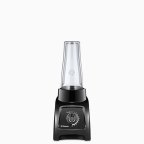 Recon S30
Recon S30  Recon 2-Speed
Recon 2-Speed  Recon 5200
Recon 5200  Recon 5300
Recon 5300  Recon Pro 500
Recon Pro 500 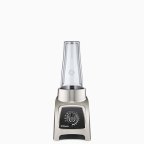 Recon S55
Recon S55  S30
S30  2-Speed
2-Speed 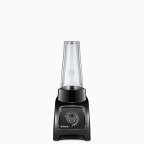 S50
S50  Recon 7500
Recon 7500  5200
5200  S55
S55 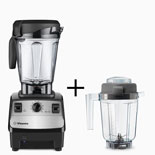 Recon 5300 + 32oz
Recon 5300 + 32oz  Recon Pro 750
Recon Pro 750  7500
7500  Pro 500
Pro 500  Recon 7500 + 32oz
Recon 7500 + 32oz  Pro 750
Pro 750 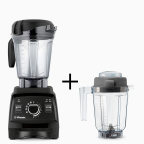 Recon Pro750+32oz
Recon Pro750+32oz  7500 + 32oz
7500 + 32oz  Pro 750 + 32oz
Pro 750 + 32oz  780
780 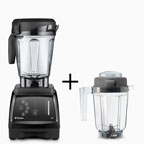 780 + 32oz
780 + 32oz(If you want the 32-oz container, you have to add it to your cart separately: 32-oz container link)
If you’re overwhelmed by the choices and just want to know my preference, I’ve used all of the different types of Vitamix blenders, and before I started using Ascent, the one I used on a daily basis was the 7500, with an extra 32-oz container for blending smaller amounts. (For the best deal, check out certified reconditioned.) All of the models are excellent, and I don’t think there is a wrong choice. (Plus, if you change your mind in the first 30 days, you can get a full refund, including free shipping both ways.)
Summary of Differences
These are the five key decisions to make when deciding which Vitamix to buy:
The following comparison chart shows the relations between the different machines in the S-Series, C-Series, and G-Series. The machines within most boxes of the chart are identical, but they come with different accessories and cookbooks (the exceptions are the S50 and S55, where the S55 has 2 more presets than the S50, and the Pro 750 and Vitamix 780, where the 780 has a flat touchpanel control). Generally the differences in accessories/cookbooks are pretty marginal, so I’d recommend going for the lowest price model within the box.

(“+” indicates there are also more expensive options in addition to the price listed in the chart. The following machines are not shown because they do not fit in with the rest: the Vitamix Turboblend Two Speed and Three Speed lack variable speed control, and the Vitamix 5300 and 6500 are a hybrid of the 6300 and 7500—i.e. they have a 7500 container on a 6300 base, without or with presets.)
Personal Blender? (S-Series vs. C-Series and G-Series)
(Vitamix S30 and S55 vs. 5200, 7500, et al.)
 In 2014 Vitamix released the Vitamix S30. It is smaller than the other Vitamix models, and also comes with a combination blending container/to-go smoothie cup. The Vitamix S50 and Vitamix S55 came out in 2015, and they are the same as the S30 but add preset modes. Since these models are significantly different from all the other models, I put up a detailed Vitamix S30 and S-Series review. If you are considering a smaller blender, or like the idea of blending in a to-go smoothie cup, you should check them out. Not surprisingly, the S-Series’ smaller size means that their maximum capacity is lower the other models (40 oz vs 64 oz).
In 2014 Vitamix released the Vitamix S30. It is smaller than the other Vitamix models, and also comes with a combination blending container/to-go smoothie cup. The Vitamix S50 and Vitamix S55 came out in 2015, and they are the same as the S30 but add preset modes. Since these models are significantly different from all the other models, I put up a detailed Vitamix S30 and S-Series review. If you are considering a smaller blender, or like the idea of blending in a to-go smoothie cup, you should check them out. Not surprisingly, the S-Series’ smaller size means that their maximum capacity is lower the other models (40 oz vs 64 oz).
Variable Speed?
(Vitamix Two Speed vs. 5200 and Vitamix 6000 vs. 6300)
 The variable speed control found on all Vitamix machines except for the Two Speed and 6000 is useful for when you don’t want to fully liquefy your blend. Examples are pesto, salsa, or chopping vegetables. If you don’t have variable speed, you can get away with quickly pulsing, but you won’t have quite as much control. The variable speed also makes the “bubble removal trick” more effective, although pulsing on low speed also works.
The variable speed control found on all Vitamix machines except for the Two Speed and 6000 is useful for when you don’t want to fully liquefy your blend. Examples are pesto, salsa, or chopping vegetables. If you don’t have variable speed, you can get away with quickly pulsing, but you won’t have quite as much control. The variable speed also makes the “bubble removal trick” more effective, although pulsing on low speed also works.
Preset Programs?
(Vitamix Two Speed vs. 6000, Vitamix 5200 vs. 6300, Vitamix Professional Series 200 vs. Professional Series 500, Vitamix S30 vs. S55, and Vitamix Professional Series 300 vs. Professional Series 750)
 The preset programs on the 6000, 6300/Pro 500, S55, and Pro 750 allow you to select a program, turn it on, and then the machine will automatically ramp up the speed and then shut off after a certain amount of time. There are a number of reasons that people appreciate this function:
The preset programs on the 6000, 6300/Pro 500, S55, and Pro 750 allow you to select a program, turn it on, and then the machine will automatically ramp up the speed and then shut off after a certain amount of time. There are a number of reasons that people appreciate this function:
• You can start the machine and “walk away” to do something else.
• If you strictly follow recipes the presets can yield more consistent results.
• Presets can give new users more confidence with the machine.
However, the presets do not work perfectly every time. Sometimes ingredients require tamping to start circulating past the blades, so you can’t always “walk away.” Also, the preset time might not be the optimum blending time if you modify a recipe. You may find that your smoothie is not fully blended after the smoothie program runs, so you have to run it again. A commercial coffee or smoothie shop makes the same recipes over and over, so in that setting presets are extremely useful. If you constantly make new combinations and of differing amounts, as many home users do, the settings may be less useful. It’s not too hard to tell when something is sufficiently blended, and after a few trials anyone should be able to figure it out. For these reasons, I personally would not pay extra for the preset settings. However, I know many people who have the presets love them. One thing to remember is that the machines with presets still have the variable speed knob for full manual control. If you don’t mind the added cost of presets, you can always switch back and forth to manual control.
C-Series vs. G-Series (Next Generation)?
(Vitamix 5200 vs. 7500, and Vitamix Professional Series 500 vs. Professional Series 750)
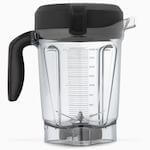 Vitamix released the “Next Generation,” aka “G-Series,” models in 2012. Both the base and the pitcher have an updated design. The base has slightly better sound muffling and also has better airflow which means that it can work harder before it overheats. To go with the better-cooled motor, the updated pitcher has a 4-inch blade instead of the Standard/Classic “C-Series” 3-inch blade. The 4-inch blade is in a shorter and wider container that has the same capacity as the 64-oz C-Series container.
Vitamix released the “Next Generation,” aka “G-Series,” models in 2012. Both the base and the pitcher have an updated design. The base has slightly better sound muffling and also has better airflow which means that it can work harder before it overheats. To go with the better-cooled motor, the updated pitcher has a 4-inch blade instead of the Standard/Classic “C-Series” 3-inch blade. The 4-inch blade is in a shorter and wider container that has the same capacity as the 64-oz C-Series container.
Advantages of the wider design:
• less need for the tamper (ingredients fall into the blades more easily)
• better chopping capability (you can course-chop more ingredients at a time)
• easier to scrape thick mixtures out
Advantage of shorter design:
• easier storage (at 17.5” tall, the container with lid on the base fits under standard kitchen cabinets)
Advantages of the 4-inch blade:
• faster processing time
• under some circumstances, marginally smoother blends
The one disadvantage of the new container is that for small volumes of under ~2 cups it does not work quite as well as the C-Series narrow container. The G-Series wider design causes two things to happen. First, there is more splashing up onto the inside of the lid and upper walls of the container, which means you lose a small amount of your blend unless you carefully scrape off the lid and walls. Second, you need slightly more volume to cover the blades and get good circulation going. The minimum volume to blend depends on what you are blending, and also on how much effort you are willing to spend pushing ingredients back into the blades. For example, for best results, the narrow containers can make nut butter easily by starting with 3 cups of nuts, whereas the wider Next Generation containers do best with 4 cups of nuts. For easier, more liquidy, blends, you can go below 1 cup in either container, but Next Generation containers will splash around more.
This disadvantage is a non-issue if most of your blends are over 2 cups, or if you are willing to spend a bit more to buy an additional narrow container, which will give you the best of both worlds. I like the 32-oz container for this purpose, although the 48-oz container has the same narrow bottom so it works just as well. The 48-oz container is just a bit bulkier on the outside because it sits outside the centering posts instead of inside of them, and its top is wider as well.
(The narrow C-Series Vitamix containers are compatible with G-Series models, but the G-Series containers are not recommended for use on C-Series models. The longer G-Series blades increase the load, and Vitamix does not recommend the C-Series cooling system for those increased loads.)
Reconditioned?
 Buying reconditioned is a great way to save money. For more details on deciding about buying reconditioned, see my refurbished Vitamix page.
Buying reconditioned is a great way to save money. For more details on deciding about buying reconditioned, see my refurbished Vitamix page.
Continue on for more details of each model type…
The array of different Vitamix blenders is a bit confusing, but it turns out that there is a lot of redundancy between the different models. I am only discussing models made for consumer/home use. Their commercial blenders are not ideal for home use because they are generally more expensive and have shorter warranties (3 years vs 7 years for home use; they are warrantied for constant use—think of how many times per day a blender at Jamba Juice runs compared to at your home).
The Vitamix website currently lists over 30 different home models, but they are all variants of three main designs: “personal” (S-Series), “standard/classic” (C-Series), and “next generation” (G-Series). For each of these main designs there are a few different options, to make a total of 8 different machine types. The rest of the models have identical bases, but come with different containers and/or accessories.
S-Series Motors
If the smaller size, dishwasher safe container, and “to-go” blending container appeal to you, please read the full details at my Vitamix S30, S50, and S55 review. For quick reference, the size of the base is 8.3″ deep x 5.9″ wide x 7.7″ tall. With the 20-oz to-go container the total height is 14.55″. The height is 15.66″ with the 40-oz container. These models have lower power, but they are still capable of making all of the usual Vitamix creations, just in smaller quantities.
C-Series Motors (Standard/Classic)
There are three types of bases of the standard variety. The differences are in the controls. The dimensions of the base of these machines are 8.75″ deep x 7.25″ wide x 8.25″ tall. There are three different container size options: 32 oz, 48 oz, and 64 oz, which result in height of base plus container/lid of 16.9″, 17.4″, and 20.5″ respectively.
Standard, no-variable speed (Vitamix TurboBlend Two Speed and Three Speed)
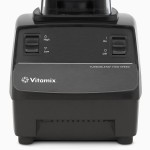 TurboBlend Two Speed (
TurboBlend Two Speed ($399$349); reconditioned for $299. This machine comes with a 5-year warranty and lacks the variable speed knob. Variable speed is useful for cases where you want to have finer control over the texture (i.e. if you don’t want a totally smooth purée). However, you can accomplish some non-liquefying chopping tasks by quickly pulsing the machine. While this is the most affordable new machine, I’d highly recommend looking at the reconditioned 5200, which has the same warranty and adds variable speed for $70 less.
In May 2016 Vitamix came out with a new no-variable speed machine, the TurboBlend Three Speed($499). It is exactly what it sounds like: it has three speed settings: low, medium, and high. It also has a pulse switch, which does the same thing as switching the start-stop button on and off. The pricing on this model is a bit strange, since for $50 less you can get a machine with fully variable speed. Plus, the TurboBlend 3-Speed comes with a 5-year warranty, instead of the 7 years on machines like the 5200.
Standard variable speed (Vitamix 5200 et al.)
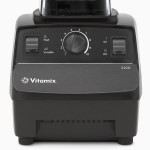 Until recently this was Vitamix’s bread and butter, and they have a lot of models to show for it: 5200 ($449), TurboBlend VS (retired), CIA Pro (retired), Pro 200 ($499), Creations II ($449), and Creations GC (retired); reconditioned for $329. These machines are essentially identical. Some are available with a shorter 48-oz container instead of the 64-oz container. The smaller container is nice because it’s more compact (and fits under standard kitchen cabinets), but of course its capacity is lower. The aesthetics of the switches and dial are slightly different between the different models. The Creations models come with a 5-year warranty, while the rest are 7 years. The 5200 comes with their “whole foods cookbook,” the TurboBlend VS comes with a vegetarian/vegan/raw cookbook and a nutmilk straining bag, the Pro models come with a cookbook with restaurant-oriented recipes (the CIA one—that’s Culinary Institute of America—comes with an additional recipe book). Note that if you buy reconditioned, you cannot choose which of the Standard models you are getting; Vitamix will choose for you based on availability, but remember that functionally they are identical.
Until recently this was Vitamix’s bread and butter, and they have a lot of models to show for it: 5200 ($449), TurboBlend VS (retired), CIA Pro (retired), Pro 200 ($499), Creations II ($449), and Creations GC (retired); reconditioned for $329. These machines are essentially identical. Some are available with a shorter 48-oz container instead of the 64-oz container. The smaller container is nice because it’s more compact (and fits under standard kitchen cabinets), but of course its capacity is lower. The aesthetics of the switches and dial are slightly different between the different models. The Creations models come with a 5-year warranty, while the rest are 7 years. The 5200 comes with their “whole foods cookbook,” the TurboBlend VS comes with a vegetarian/vegan/raw cookbook and a nutmilk straining bag, the Pro models come with a cookbook with restaurant-oriented recipes (the CIA one—that’s Culinary Institute of America—comes with an additional recipe book). Note that if you buy reconditioned, you cannot choose which of the Standard models you are getting; Vitamix will choose for you based on availability, but remember that functionally they are identical.
Sometimes these models are listed with their color-specific SKU. All of the following models are identical to the 5200, they just come with different colors and names: Vitamix 1709, 1363, 1364, 1365, 1709, 1723, 1732. They also sometimes go by VM0103. Vitamix 1978 is also the same, but comes with a 48-oz container.
Standard variable speed + presets (Vitamix 6300 and Professional Series 500)
 Pro 500 ($559) and 6300 (retired); reconditioned for $379. These are the same model; the only difference is that the 6300 comes with the “Savor” cookbook, which has a broader range of recipes than the Pro 500’s “Create” cookbook, which focuses more on restaurant-style recipes that tend to be richer.) They have 3 preset programs that run the blender for a certain amount of time and speed for smoothies, frozen desserts, and hot soups. Their switches are slightly different from the non-preset models. The non-preset models have an on-off switch, a variable speed knob, and a high-variable speed switch. The preset ones have moved the highest speed setting onto the knob and replaced the high-variable speed switch with a pulse switch. This is really a minor aesthetic difference, since you can achieve pulsing on the non-preset models by quickly flicking the on-off switch on and off.
Pro 500 ($559) and 6300 (retired); reconditioned for $379. These are the same model; the only difference is that the 6300 comes with the “Savor” cookbook, which has a broader range of recipes than the Pro 500’s “Create” cookbook, which focuses more on restaurant-style recipes that tend to be richer.) They have 3 preset programs that run the blender for a certain amount of time and speed for smoothies, frozen desserts, and hot soups. Their switches are slightly different from the non-preset models. The non-preset models have an on-off switch, a variable speed knob, and a high-variable speed switch. The preset ones have moved the highest speed setting onto the knob and replaced the high-variable speed switch with a pulse switch. This is really a minor aesthetic difference, since you can achieve pulsing on the non-preset models by quickly flicking the on-off switch on and off.
Some people love the presets because you can set it and walk away (assuming the mixture is circulating and you don’t need the tamper), and because they get more consistent results. However, the more consistent results will only hold if you always add the same quantities and types of items to the blender. For example, if you’re making a small smoothie, you can blend it for less time than if you were making a large one. One other thing is that you can set the non-preset machines and walk away—you just have to come back to stop them. I often use the blending time to rinse off the knife and cutting board that I used. You’re not likely to forget that the Vitamix is running because it’s loud enough to hear throughout the house. The variable speed knob goes to the same high speed as the previous models on high, but it’s lowest setting is a bit faster than on the 5200 et al., so you lose a tiny bit of fine control. Whether the presets are worth it is a personal question—I wouldn’t pay extra for them, but some people love them.
Standard no variable speed + presets (Vitamix 6000)
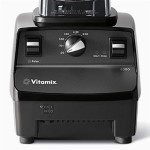 6000 (retired). Released October 2013, this is more of a mash-up of existing machines than a truly new one. It’s a sort of blend between the Two Speed, and the 6300. It does not have variable speed control, but it has six preset timed blending settings. These settings will automatically ramp up the speed, and then turn it off after a specified time of 20 sec, 30 sec, 1 min, 1.5 min, 4.5 min, or 6.5 min. Like the 6300, the pulse control is spring-loaded so that it only stays on as long as you hold it down, and it blends at a medium-low speed.
6000 (retired). Released October 2013, this is more of a mash-up of existing machines than a truly new one. It’s a sort of blend between the Two Speed, and the 6300. It does not have variable speed control, but it has six preset timed blending settings. These settings will automatically ramp up the speed, and then turn it off after a specified time of 20 sec, 30 sec, 1 min, 1.5 min, 4.5 min, or 6.5 min. Like the 6300, the pulse control is spring-loaded so that it only stays on as long as you hold it down, and it blends at a medium-low speed.
G-Series Motors (Next Generation)
In 2012 Vitamix released a new generation G-Series base with improved airflow that makes it run cooler and quieter than the classic C-Series one. With the improved cooling, the G-Series base can use a new pitcher design that is wider and has longer blades. This design makes the tamper less necessary, and makes it easier to get thick mixtures out. The longer blades also process food faster and work better for chopping. The G-Series machines are compatible with the C-Series containers, so if you want to use the dry blade you can use the same classic dry container. Dimensions are 9.4″ deep x 7.7″ wide x 17.5″ tall (with new-style 64-oz container in place). For more details of sizes, check out the PDF footprints I made for my Vitamix S30 review.
Next generation motor (Vitamix 7500, Professional Series 300, and Creations Elite)
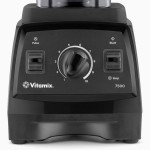 7500 ($529), Creations Elite ($557.50), and Pro 300 ($559); reconditioned for $439. These are all the same machine, so don’t worry about the note on the Reconditioned Next Gen page that says that the label may reflect any of these models. The only difference is the name printed on it. One point of confusion is that the Creations Elite is sold new with a smaller container, but if you happen to get sent a Creations Elite as a Reconditioned Next Gen, it will come with the same low profile 64-oz container that the 7500 comes with.
7500 ($529), Creations Elite ($557.50), and Pro 300 ($559); reconditioned for $439. These are all the same machine, so don’t worry about the note on the Reconditioned Next Gen page that says that the label may reflect any of these models. The only difference is the name printed on it. One point of confusion is that the Creations Elite is sold new with a smaller container, but if you happen to get sent a Creations Elite as a Reconditioned Next Gen, it will come with the same low profile 64-oz container that the 7500 comes with.
Next generation motor + presets (Vitamix Professional Series 750 and Vitamix 780)
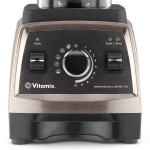
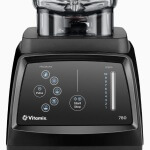 Pro 750 ($599–$649), 780 ($719); available reconditioned: 750 for
Pro 750 ($599–$649), 780 ($719); available reconditioned: 750 for $519–$569$499, and 780 for $519$399. These models have 5 presets: smoothies, frozen desserts, purées, hot soups, and self-washing. If you want to see more details of exactly what the presets do, check out my page about demystifying Vitamix presets. The 780 is identical, except that it has a touchpanel control interface. See my Vitamix 780 review for more details.
Vitamix Heritage 750 vs. Original 750?
In late 2015, Vitamix released a new version of the Pro 750: the Heritage line. The Vitamix Heritage 750 is functionally equivalent to the original Pro 750, but it has two differences on the exterior of the base. The upper shell (see diagram below) is now metal on the Heritage models. The Vitamix website doesn’t put Heritage in the model title, but it’s there in the description.
 The original 750 came in a brushed stainless finish option, but the upper shell was plastic with a thin metallic coat that could be scratched or scuffed. (When I tested the original 750 for a couple of months, I did not see any problems, but I have heard that some people have noticed scratches/scuffs.) The solid metal of the new Heritage models is more durable. Also, the metal shell muffles the the motor a bit more than the plastic, making the Heritage models a bit quieter.
The original 750 came in a brushed stainless finish option, but the upper shell was plastic with a thin metallic coat that could be scratched or scuffed. (When I tested the original 750 for a couple of months, I did not see any problems, but I have heard that some people have noticed scratches/scuffs.) The solid metal of the new Heritage models is more durable. Also, the metal shell muffles the the motor a bit more than the plastic, making the Heritage models a bit quieter.
 The other minor difference is that the Heritage models’ front panel has fewer backlights: Heritage models light up the indicators above the pulse and start-stop switches, whereas the original Pro 750 has backlights around the central knob as well.
The other minor difference is that the Heritage models’ front panel has fewer backlights: Heritage models light up the indicators above the pulse and start-stop switches, whereas the original Pro 750 has backlights around the central knob as well.
The Heritage metal is available in brushed stainless and copper finishes. (Currently on Vitamix.com, the Heritage options are listed on the main Pro 750 page, and the old brushed stainless finish is discontinued.)
I believe it is called Heritage because it is a throwback to the original Vitamix models that had all-metal bases. The plastic that Vitamix has been using for their bases for the past 25 years is extremely durable, so this change won’t affect functional longevity. That said, the elegant finish of the Heritage models will now likely stay unblemished for longer. It’s also nice that Vitamix did not increase the price for this upgrade.
The Vitamix 5300 and 6500
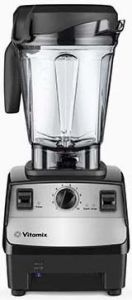 5300 ($529) and 6500 ($599); reconditioned for $360. Vitamix does not currently sell the new models online, only the reconditioned one. These are “new” models for 2015, although they are actually just slightly unexpected mash-ups of previous models. They are a hybrid between a 6300 and a 7500. They use the wide Next Gen (G-Series) container but they have a Classic (C-Series) base. The 5300 has variable speed and a pulse control switch, and has no presets. Meanwhile, the 6500 has the same three presets as the 6300. (Further evidence of equivalence between the 5300/6500 and C-Series models is on the Reconditioned C-Series 6300/Pro 500 page: it says its base may be a 6500.)
5300 ($529) and 6500 ($599); reconditioned for $360. Vitamix does not currently sell the new models online, only the reconditioned one. These are “new” models for 2015, although they are actually just slightly unexpected mash-ups of previous models. They are a hybrid between a 6300 and a 7500. They use the wide Next Gen (G-Series) container but they have a Classic (C-Series) base. The 5300 has variable speed and a pulse control switch, and has no presets. Meanwhile, the 6500 has the same three presets as the 6300. (Further evidence of equivalence between the 5300/6500 and C-Series models is on the Reconditioned C-Series 6300/Pro 500 page: it says its base may be a 6500.)
The reconditioned 5300 is the most affordable option for a machine with the short/wide container.
The strange thing about these models is that previously Vitamix stated that Next Gen containers should not be used on Classic bases because they do not have the updated airflow design that cools the motor more effectively.
I strongly suspect that the 5300 has the same microprocessor speed control as the 7500, Pro 750, and 6300, just without the presets. (You can read about the speed control of the different machines on my Vitamix RPM measurement page.) The microprocessor speed control should help protect the motor when using the wide container at high loads and very low speeds, but at maximum speed it shouldn’t make a difference. The marketing copy for the 5300 says that it comes “with a faster, yet quieter, motor,” but I am skeptical of those claims [Update: interestingly, Vitamix removed that phrase].
The 5300 and 6500 are a bit louder than the G-Series bases, which have sound-dampening technology not present in the C-Series bases. At the same price point, I would prefer the 7500.
Satisfaction Guarantee
Vitamix has a 30-day satisfaction guarantee, so if you have second thoughts you can return a machine within the first 30 days for a full refund and they even pay return shipping.
Warranty
If your machine has any problems during the warranty period of 5 or 7 years, Vitamix will repair or replace it, and they cover shipping costs both ways. For more details about warranties, check out my Vitamix Warranty page.
Reconditioned Vitamix
 I know I already mentioned reconditioned machines, but I want to restate what a great deal I think they are. These factory-refurbished machines offer the best prices you’ll find on Vitamix: 5200 for $329, Pro 500 for $379, and 7500 for $439. For more details, see my refurbished Vitamix page.
I know I already mentioned reconditioned machines, but I want to restate what a great deal I think they are. These factory-refurbished machines offer the best prices you’ll find on Vitamix: 5200 for $329, Pro 500 for $379, and 7500 for $439. For more details, see my refurbished Vitamix page.
Payment Plans
Want to start blending right away, but don’t want to pay the full price up front? Vitamix offers payment plans with zero interest and no fees if you make payments on time. For more information, check out my payment plan page.
Free Shipping
Clicking on any Vitamix link on this page will automatically apply a promotion code, which gives you free shipping on your order of a Vitamix machine (or anything else on Vitamix.com over $50) in the U.S. or Canada. For more details, see my page about the Vitamix promotion code.
Extra Bonus
If you order via a link on this site, Joy of Blending can get a commission. I deeply appreciate your support, and, to thank you, I want to help you get the most out of your new machine. I try to answer all questions from everyone, but sometimes I get swamped. If you order through one of my links, I will give you a private way to contact me so that I can answer your questions before visitors who are not on the special list. Please make sure my link is the last link you click before placing your Vitamix.com order. Then just forward your order confirmation to thanks@joyofblending.com.
Recommended Accessory
I highly recommend a spatula for getting the last bits of thick mixtures out of the container. For the narrow containers I recommend a long narrow spatula. For the wide containers, I recommend Vitamix’s under-blade scraper.
Dry Container
If you’re wondering if you should get a dry container, this new post is for you: Is the dry container worth it?
Phew… so that completes the Vitamix model round-up. I’m looking forward to getting back to describing some actual recipes!
Or follow along on Twitter or Facebook:

Why does the Vitamix Creations Elite only have a 5 year warranty and not a 7 year warranty???
The Creations models were branded specially for sale on QVC, and I think part of the discounted pricing agreement between Vitamix and QVC is that those models come with the shorter warranty.
I just bought the Creation Elite from QVC thinking it was the machine (7500) I bought for my daughter’s family for Christmas. She LOVES her Vitamix and uses it 3x a day and puts everything in it for perfect smoothies, soups. Will I be able to do the same thing with the Creations Elite?
You can make most of the same things, but the 7500 has the wider container that allows for better chopping, easier access to removing thick mixtures, and less need for the tamper.
Hi Adam-Thank you for all your wonderful information. It is very helpful. I purchased a 6300 yesterday at Costco. I couldn’t decide between that and a refurbished 7500. I’m kind of wishing now that I would have gotten the 7500 instead. I have not unpacked the 6300. What would you advise? Keep the 6300 or return it and order the refurbished 7500? Thanks for your help.
I personally would rank the wider container over the presets, so I would choose the 7500.
Alternatively, if the presets of the 6300 are appealing to you and you want to save money, you could get a reconditioned version of that machine (“Standard Programs”) for less than the Costco price.
I was considering the Creations Elite on QVC today. It looks like it is the same height with the 48 ounce container as the regular 7500 with the 64 ounce container. Is that correct? The 7500 will not fit on my counter and I was hoping the 48 ounce container would. Do you have any comments on the pros/cons of getting the Creations Elite? I know the reconditioned 7500 is a better deal, but my husband is adamantly against purchasing reconditioned items… Thanks!
Yes, the Creations Elite with 48-oz container is just about the same height as the 7500. The difference is the container width, so pros of the 48-oz (Creations Elite): better for minimum volume blends, pros of wide 64-oz (7500): better chopping, easier access for removing thick mixtures, and less need for the tamper.
I hate to open a whole new can of worms, but if fitting under cabinets is extremely important to you and your cabinets are on the low side, it might be worth checking out Blendtec machines, which are 15″ tall.
I understand generally wanting to avoid reconditioned items, although in the case of Vitamixes I don’t think there’s any reason to be concerned. The units have very little use (demos or home trials), then they are fully checked over, and just in case there is a problem, they come with the same strong type of warranty as new machines. And the parts most likely to have cosmetic wear (pitcher, tamper, cookbook) are replaced with brand new ones.
Thank you once again for your informative and quick reply! Fitting under the cabinets would be a big plus, but it isn’t a deal breaker for me. My older daughter is extremely texture sensitive and I understand the Vitamix blends smoother smoothies. I also read online that with the Blendtec digital controls, it takes longer to move from one speed to another. Have you heard anything about those? Thanks!
The new Designer Series Blendtec has a touch slider interface, so you can quickly change the speed (the Classic Blendtec you would have to punch the up/down arrows). I personally like having the physical knob Vitamix offers though.
Another thought on fitting under your cabinets is that a Vitamix may fit without the lid, or with the lid or container inverted. If you invert the container and put the lid on top, it’s a little less than 17 inches tall.
Good to know about the new Designer Series Blendtec. Thanks! I’ll look into that.
My plan is to store it with the lid inverted. I borrowed my friend’s Pro 300 when she went out of town for a week and saw that it fits perfectly if I store it like that. Thanks again!
Thanks for your reviews on the Vitamix. I recently bought a 6300, which I love, but am/was consideirng the 750 as well as the 7500. With regards to the 750, the person running the roadshow stated that the motor was 40% quiter? Have you or anyone found that to be true? I was also considering buying the 32 or 48 oz containers, would these work with my machine? I assume that the 6300 uses the older style base so…
The 750 and 7500 (“next generation”) have improved sound shielding of the motor. It’s most apparent when running the motor at less than top speed, although even at top speed the next generation motors are quieter. However, the improved muffling of the motor does not affect the noise from ingredients bouncing around the container, so if you blend something really hard like ice, it will still be loud. The short answer is, yes they are quieter, but depending how fast and what you’re blending, the difference may not be very large.
The 32 and 48 oz containers work on all models.
Hi Adam, first of all, I am really thankful to you for having written this article and tirelessly answering people’s questions. I have a few questions of my own if you don’t mind. I bought a 5200S from Costco today. I love the thing! It pulverized the small seeds in my smoothie (blackberry seeds, chia seeds etc).
However, it’s ridiculously noisy and I live in a small apartment. I am contemplating returning it and ordering a reconditioned 7500. Here are my questions:
1. Is the 7500 really 40% quieter in real life? I know you said that it won’t really matter much at top speed.
2. Will the 7500 liquify the small seeds as well? I am concerned due to the larger base of it’s container.
3. There is no high switch on the 7500. Is the ‘variable 10’ on the 7500 equivalent of the ‘variable 10 + high’ on the 5200?
4. What is the average life span of a Vitamix? I am concerned for having only 5 years of warranty vs 7.
5. Out of warranty, how expensive will it be to get something repaired?
6. Lastly, will they pay return shipping if I order the 7500 but decide against it within 30 days? Also, do they provide free two way shipping for warranty repairs?
Sorry for the long post. Hope to hear from you soon.
Great to hear you’re enjoying your machine. I’ll try to answer your questions:
1. It depends; see my answer to the previous question above yours. Also, depending on the acoustics of your kitchen, a foam pad under the blender can help dampen noise a little bit. I like to use ear protection.
2. Yes. The wider base only becomes an issue at the lower limit of blending volume.
3. Approximately yes. (Note on the 5200 when on high the variable speed setting does not affect speed.)
4. I do not know the hard numbers, but anecdotally I know many machines that are still going after 15 years.
5. Depends on what breaks. Drive shaft can be replaced for $10-15, motor repairs I think start at $150 and go to $250 for a complete machine overhaul. (At which point you’re probably better off using their $100 trade-in credit for a new machine.) You may also be able to get it fixed at a local appliance repair shop for cheaper.
6. Vitamix pays for return shipping on 30-day trial returns. And they provide free two-way shipping on warranty repairs. (They’ll send/email you a prepaid shipping label.)
Thanks a lot Adam! Ordered the reconditioned 7500 this morning. Will get those earmuffs you recommended as well. Found them on Amazon.
Got my Pro 750 yesterday, and I’m a little intimidated by it–afraid I’m going to do something wrong and blow it up!
I made peach soy sherbet tonight, but I didn’t use the tamper from the start, and then everything stopped circulating and it seemed like the machine was starting to overheat. So I hit stop and we ate chunky peach sherbet. It still tasted good.
The cookbooks are a little overwhelming too. I don’t want to make gourmet meals; I just want to make healthy food. Too many of the recipes call for ingredients I don’t have and/or wouldn’t ordinarily buy. I would like to throw in a bunch of what I have on hand and make a smoothie. Can I do that, or do I have to follow the recipes?
It’s going to take some getting used to!
It’s natural to want to protect your precious new investment, but the machine is tough, so you shouldn’t worry about babying it. In the situation you described it would be fine to start using the tamper, even though you weren’t using it from the start. In fact, it’s natural to only start using the tamper if the ingredients are not circulating.
New machines can have a slight burning rubber smell the first few times they are run at high load, but that’s normal, and it should go away after a few uses (there’s a coating on the motor windings that cures). Also, remember that if your motor does happen to overheat (it’s relatively unlikely to happen) the thermal overload sensor will kick in and turn off the machine to protect the motor. It’s a bit of an inconvenience because you have to wait for the motor to cool before you can run it again, but it shouldn’t do any serious harm.
I’m not that big a fan of a lot of the cookbook recipes, which is part of why I was inspired to create this site. For the most part I aim for simple and healthy so I hope you’ll find some ideas by poking around here.
You should absolutely experiment with throwing in whatever you have on hand for smoothies. The thing about smoothies is you can adjust them really easily. (Too thick? Add liquid. Too warm? Add ice. Flavor not quite right? Add something sweet or sour. etc.) The only time smoothies are not easily adjusted is if you have already added a lot of something with a really strong flavor (like maybe a ton of ginger or a bitter vegetable). If that happens you just have to remember to add less in the future, but it’s not really that big a deal. As you make more smoothies you’ll learn what sort of things you like so that ultimately you rarely have to make adjustments.
One other side note about creating your own blends: one guiding principle is to think about if something would taste good outside of the Vitamix. The Vitamix can turn just about anything into a smoothie, but that doesn’t mean it will taste good. For example, you probably don’t want to just throw in every vegetable you have in your fridge. (I do like a nice well-balanced savory blend though.)
If you have any other difficulties or challenges with your machine, I’d be like to hear about them because I’m realizing that it may be useful to make a “getting started” post. I realize it’s intimidating at first, but it’s a little tricky for me to get into the mindset of a new user, since I’ve been Vitamixing for over seven years.
Adam, thanks for understanding my anxiety and for the calming assurances. Besides blowing up the machine, I’m worried that if things don’t turn out right I will feel like I made a bad decision to purchase the VM. So that gives you another insight into the mind of a somewhat obsessive first-time user who has just spent a ton of money on a kitchen appliance. 😉 I’m sure that once I have a few smoothies under my belt, I will begin to feel more confident.
A getting started post from you would be very helpful. What VM provides is really just a chef zipping through everything that can be done with the machine.
Today I am tackling almond milk and perhaps a smoothie.
Adam, I think you said you are vegetarian, so you know how time consuming it can be to prep everything for meals. Do you do most of your chopping in the VM? That would sure make life in the kitchen easier! Any tips for when to use dry/wet methods?
I haven’t used the Vitamix for chopping as much as I could. When I first got it I was too worried about liquifying ingredients, but I’ve now learned that chopping can work well. I hope to try it more in the near future. I did make a post about chopping ingredients for coleslaw a little while back. I’m still learning what works best for chopping, so I don’t really know anything beyond what’s in the Vitamix manual/getting started guide; they have some good information there. (Briefly, dry chopping is usually used for smaller quantities. The main things I’ve seen wet-chopped are cabbage and potatoes.)
Hi Adam,
I returned my vitamix 6300 and ordered a certified reconditioned new generation. I wanted one that would fit under the counter and was having some issues with food or ice not mixing and didn’t want to have to mess with the tamper so much. This one mixes really well, I was just noticing that the consistency of my smoothies is more frothy instead of icy with this machine. Do you think it’s because of the wider base and more air is getting in? I’m using basically the same ingredients as I did with the 6300. Do you have any ideas on what I could do to make the consistency less frothy? Thanks for the time you take to help everyone with our questions!!
You mentioned that your blends are coming out more frothy and less icy, so the first thing to try would be to blend for less time. The longer blades may process the same ingredients faster, so you may be slightly overblending them if you’re using similar times as you had been with the 6300. You could also add more ice or frozen fruit to make it more icy. Finally, you can try the “remove bubbles trick.”
I’m happy to answer questions because I want everyone to be able to get the most out of their blender. Also getting the questions helps me understand what people have trouble with and gives me new ideas for future directions on the blog.
Hi,
I plan to buy refurbished 7500. Before I place order, I just want to check with you one thing.
From the latest consumer report(issued May 13). 5200 is rated higher than 7500. It indicated two areas 5200 is slightly better.
1. Ice drinks(smoothies)
2. Convenience(the explanation for this says, it includes ease of cleaning and replacing blade, clarity of controls, and jar markings, pouring ease, and jar balance makes up the “Convenience” score).
I don’t trust consumer report much after I tried the one rated top. It put Ninja Master Prep as the top 1. I bought it from Kohls with 20% coupon. Good deal. However, it really cannot break small pieces, the small piece from strawberry(not even seed). So, I returned.
Now, I am ready for the Vitamax. Can you make comments in the two areas. Is 5200 better than 7500 in the above 2 areas ?
Thanks,
Leland
Please see my response above to Heather on April 7 for a discussion of the consumer reports ratings. The short answer is that I wouldn’t give them much weight because their tests are geared to test standard blenders and don’t really put the powerful blenders through their paces.
Sorry, I didn’t realize the consumer report issues have been discussed before. I just went through all the discussion. I guess your right. Consumer report staff may not put enough volume to test.
The Ninja master prep is completely a joke after I purchased, used and returned it. My 10 years old son immediately feel it’s not smooth for the strawberry.
Anyhow, I started having more doubt about Consumer Report test. Last time I followed its review to purchase a top rated LG washer. It turned out not that good. I am really not sure how they do the test.
Hi,
I’m super excited that I found your site.
What is the difference in the motors?
Which is the most powerful?
Creations Elite: 2.2-peak HP motor
Creations II: 2-peak HP motor
Creations GC with Compact Container: 2+ peak HP motor
Where can I find the WATTS of the base?
Thanks.
The differences in the power ratings are minimal. The biggest difference between those models is that the motor in the Creations Elite is designed to handle higher loads of the 4-inch blade (which comes with the 750 and 7500).
The power ratings of those three models are 12, 11.5, and 12.5 amps respectively. To get watts, multiply by the voltage, which 120 volts (standard US/Canada mains), so that yields 1440, 1380, and 1500 watts respectively. So the Creations GC is the “most powerful,” but it’s not a significant difference.
The Creations GC is the only Vitamix with that motor rating, which sort of makes me suspect that it’s a marketing gimmick that Vitamix created for QVC, so they could call it “the most powerful Vitamix we’ve ever sold.” I’m not aware of any tests that compare performance of the Creations GC to the other models, but I really don’t think it’s significantly different.
Hello, Adam. I have to say Your comments, review and posts are amazing. Thank you for your hard work, time and patience with all of us asking the similar questions 😉
Thanks to all your posts that I have been reading for last hour I m about to place order. So far I am thinking about reconditioned 5200 or 7500. I am going to make a 1 serving green smoothe at the beginning and looks like your recommendation would be to purchase 5200 for a smaller portions (less than 2 cups). Since Vitamax are such great blenders and can be at great work for decades I was thinking that later I will might need to do the larger servings for my family. Should I get 7500 and it will be still ok for now for smaller portions ? Or i better stay with 5200 ? Which size of cup would your recommend? Could please provide the link again for refurbished 5200 or 7500. Thank you for your time. I am so excited for my first Vitamax. Can’t wait to make some green smoothes. Sincerely, Olga
Ha ha 😉 I just realized I was calling it Vitamax instead of Vitamix 😉 I guess in my mind I wanted the Max results from it 😉
A few thoughts: 1) To me, 2 cups is a reasonable single-serving smoothie. 2) The 7500 wide container can make smoothies under 2 cups, going down to about 1 cup, it’s just that it’s more likely to require you to coax ingredients into the blades. The narrower containers will work a bit better for the low volumes. So the point is that you could just get the 7500, and it should work for your single-servings, but if that’s the main thing you’re doing it’s not optimal.
So which should you get? It sounds like a 5200 would be a good choice for you, but it depends a bit on your finances now. For maximum versatility, you’d get the 7500 with an additional small container, but that will cost a bit more. If your main use is blending small smoothies, the 5200 will work just as well, and will save you a bit of money. I would recommend the 5200 with compact container (48-oz) for your single-serving use, which is sporadically available reconditioned. The ordering details are available above in a comment reply to Victoria on April 2. Links to the other refurbished machines that you can buy online are in the main post in the section reconditioned machines.
This page is getting a bit long, so I’m going to try to stop repeating information. If you’re looking for something and don’t want to read the whole thing, try a text search. To do that press Ctrl+F (PC) or command+F (mac) and type the word you’re looking for. If you’re on another device, figure out how to “find on page,” it will save you a lot of time. iOS Android
If in the distant future you want to upgrade, you could take advantage of Vitamix’s $100 trade-in program (assuming it’s still around), or you could always gift your old machine.
I purchased the Vitamix 750. I used it to make smoothies, hummis, sorbet and really liked it (e.g., the presets), but found it to be too noisy. Do you have any suggestions for another Vitamix model (e.g., commercial grade withe cover) or another blender that would be less noisy, but produce similar results? Or is there a cover or something else I can get to reduce the noise on my Vitamix. Thanks
That’s the quietest high-speed blender. Many people don’t have a problem with the noise, but it can be an issue for some. My solution is to wear earmuffs, which I described a while back. I recently got a second pair, so if someone else is nearby they can pop them on. Depending on the acoustics of your kitchen, a foam pad (like a mouse pad) under the blender may help a little.
Vitamix does not make sound enclosures for their consumer models. There are some 3rd party ones, but Vitamix is concerned about them impeding airflow for cooling, so the 3rd party ones will void your warranty. There are commercial Vitamixes that come with enclosures, but they are quite expensive, have short warranties, and are optimized for frozen beverages, so they are not ideal for the home kitchen. It would be nice if Vitamix offered a consumer sound enclosure, but I think the reason they don’t is because it would be bulky and would get in the way of adding additional ingredients and tamping.
There is one brand of high-speed blender (Omni) that does offer sound enclosures for home use, but they are not in the same class as Vitamix. You can find them here.
First, thank you for your efforts in answering so many questions and your patience. I have read the above several times and all of my own questions have have been noted. At first, I was all set to buy the reconditioned 5200, but then after noting the height differences of the 7500 I am set to purchase it. The reason is one not mentioned directly. With the lid inverted the container seemingly will fit in the refrigerator. This is important to me because my wife has health problems and can usually not drink the smoothie until a little later. Thus being able to store the drink briefly is an advantage!
Adam – You are so patient and kind and detailed in your post and replies. Thank you for the time you invest in helping others.
It seems you can’t trust a lot of the information given by the “salespeople” at the places like Costco and places like State Fairs. I also received a bunch of misinformation at the Minnesota State Fair last summer so that I would buy the particular model that guy was selling. Except he was also really rude when I tried to ask questions about other models, so I walked away.
Does anyone with a Pro 750 or Pro 300 use the 32 oz or 48 oz container on their machines? If so, how do you feel the bending ability is compared to the 64oz standard container?
Nik,
I have a 7500 and recently added a 32-oz container. I’ve only made frozen yogurt in it so far, so I can’t really speak too much to the blending ability compared to the standard 64-oz container. But conceptually, the 32-oz only has 3-inch blades vs. 4-inch blades on the 64-oz container, so I would think it simply cannot do as well.
That’s the one and only downside of the 7500 if you are willing to add a smaller container (which I did thanks to Adam’s comments) compared to the 5200 — that since the 7500 can only go up to 24,000 RPM vs 37,000 RPM on the 5200, when you use containers with 3-inch blades the performance at the highest setting is likely to be worse on the 7500.
But since I’ve had my machine for only a month, I’d like to hear Adam’s thoughts or others that have owned the combination longer.
Ken, you raise a good point about blade length/speed that I’ve thought about a bit myself. Unfortunately at this point I haven’t done testing so I can’t comment on the practical implications (I hope to do direct tests at some point). For most things I don’t think the difference in max speed will make much difference. (The speed is more complicated than just the advertised max speed: it also depends on load, and I think the two motors respond differently to load.) I think the main difference will be the one I’ve previously mentioned: that low volumes stay in better contact with the blades with the narrower containers.
Ken
Thanks for the reply. In my experience blending with the 48 oz container on the Pro 750, the consistency of the blend is definitely not as smooth as the 48 oz on the 6300 (or the new 64 ox on the Pro 750). This is unfortunate because I really like using the smaller container. At this point, Im not aware of any plans to make a smaller container with 4″ blades for proper use on the Pro 750. I’ve heard talk of there being a microprocessor in the 750 that can detect the mix and control the blade a little, Im not sure how much of that is true. To me the extra 0.2 HP on the new machine while still spinning at a lower RPM doesnt seem to make much sense.
Does Vitamix sell a refurbished commercial ones? Just looking to set up one at my store for smoothies. Probably no more than 20 a day. Thanks for your help
I do not think so, although I’m not sure since I’ve only dealt with their home sales division. For light commercial use you could use a home machine, but remember that the warranty would be void.
Update to earlier post. What I meant to say was that I wanted to be able to fit the 7500 under my cabinet. I am hoping that by inverting the lid etc. it wiil allow this, since my my cabinets are only 16 and 3/4 inches above my counter. Do you think this will work? Also, the refurbished 7500 is currently out of stock, I am hoping they will have more available soon! Thanks for your helpful info.!
I think you’ll be able to fit it with an inverted lid and/or container. The reconditioned 7500 is still in stock in red (though they could sell out at any time). I’m not surprised that they’re running out of stock of these machines since they’re such a good deal.
I have recently purchased a Vitamix creations elite. Now, I am looking for the weight loss smoothie recipes I can use. I bought this machine because ppl said it is the best. Pls recommend either a website or where I can get weightloss recipes for smoothies/soups. There are so many recipes, I am not sure which ones will help me lose this weight. I do have over 100 lbs to lose. Thank you for your help. My health is at stake.
Have you checked out my recipes section? I don’t focus on weight loss, but I generally focus on recipes that have whole foods with no added sugar, which should help with weight loss.